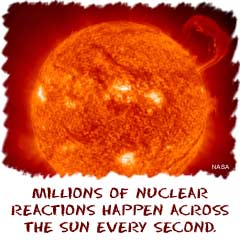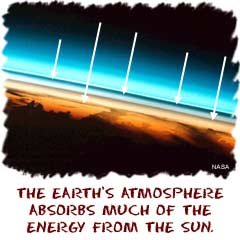Radiant Energy From The Sun
 Radiant energy is also called electromagnetic energy. Almost every reaction that happens on the surface of the Earth is the result of energy coming to the Earth from the Sun. Radiant energy is also called electromagnetic energy because it is made up of two combined fields. One of the fields is electrical and the other is magnetic.
Radiant energy is also called electromagnetic energy. Almost every reaction that happens on the surface of the Earth is the result of energy coming to the Earth from the Sun. Radiant energy is also called electromagnetic energy because it is made up of two combined fields. One of the fields is electrical and the other is magnetic.
One other thing to remember: when we talk about incoming radiation, we don't always mean radiation like X-rays, or radioactivity. Light is radiation of some kind. All light is one form of radiation or another. Just keep that in mind.
Constant Output Of Energy
Solar radiation is light energy from the Sun. So you've got the Sun. Millions of kilometers away from the Earth it sits there with all sorts of nuclear reactions going on. It's constantly giving off a huge amount of energy and radiation. By the time the energy and light reach Earth, there isn't much energy left. Scientists have figured out something called a solar constant. The constant is the amount of radiation that actually hits the Earth. They say it's about 29.4 MJ (Megajoules, a unit of energy) for every square meter for each day.Constant Input Of Energy
 The flow of energy to the Earth is constant. That constant flow is just the amount of EM radiation hitting the outside of the atmosphere. The energy from the Sun has changed by the time it hits the surface of the Earth. At the top of the atmosphere you have the 29.4 MJ. We only see about 17 MJ of energy at the surface of the Earth. Something had to happen to the EM radiation between the top of the atmosphere and the surface of the Earth. Energy and certain types of EM radiation (Infrared and Ultra Violet) have been filtered away.
The flow of energy to the Earth is constant. That constant flow is just the amount of EM radiation hitting the outside of the atmosphere. The energy from the Sun has changed by the time it hits the surface of the Earth. At the top of the atmosphere you have the 29.4 MJ. We only see about 17 MJ of energy at the surface of the Earth. Something had to happen to the EM radiation between the top of the atmosphere and the surface of the Earth. Energy and certain types of EM radiation (Infrared and Ultra Violet) have been filtered away.
Not Always Constant At The Surface
Several factors determine the amount of radiant energy hitting the Earth. Our planet is a specific distance from the Sun. Even though we have a slightly elliptical orbit around the Sun, we can expect a certain amount of energy to hit our planet. If we were closer there would be more energy hitting our atmosphere and if we were further away there would be less energy. We also have a Sun with special characteristics. As our Sun gets older, it will begin to expand. That increase in size is going to affect the amount of radiant energy hitting our atmosphere. The solar constant is based on the Sun's activity now.
Or search the sites for a specific topic.
- Overview
- EM Spectrum
- Quanta
- Waves
- Solar Radiation
- Emittance
- Balance
- Global Geometry
- Movement
- Interaction
- Transmission
- Temperature
- More Topics

Solar Radiation and Sea Ice (NASA/GSFC Video)

Useful Reference Materials
Encyclopedia.com (Solar Wind):http://www.encyclopedia.com/topic/solar_wind.aspx
Wikipedia (Sunlight):
http://en.wikipedia.org/wiki/Sunlight
Encyclopædia Britannica:
http://www.britannica.com/EBchecked/topic/121560/climate/53245/Solar-radiation





